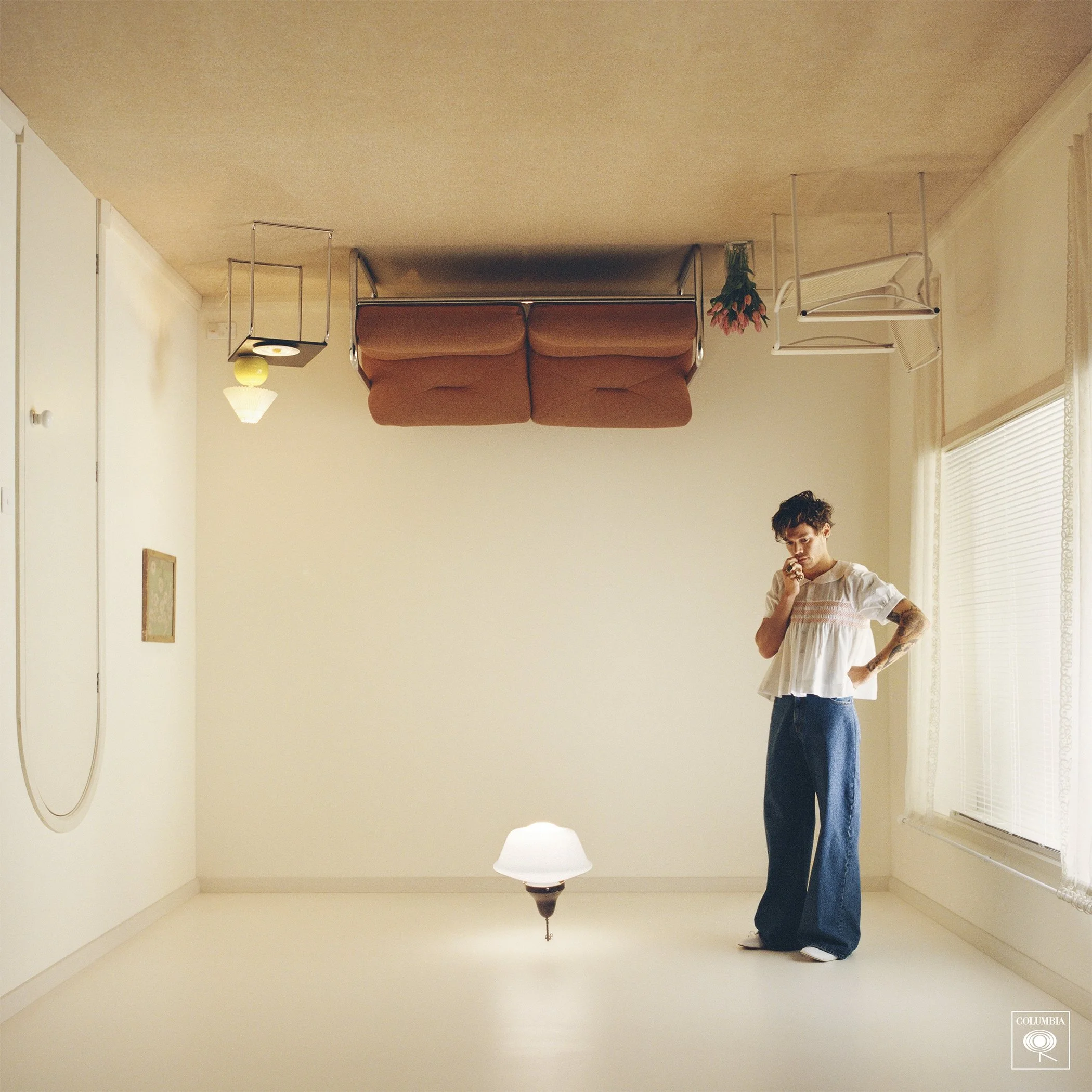Album Review: Harry Styles, ‘Harry’s House’
In the time since 2019’s Fine Line, Harry Styles has blossomed into one of the defining pop stars of the current era. A new-age sex symbol that bridges film, fashion, and music, and honors the foundation of 70s rock stars, Harry has come a long way from his One Direction days. Harry’s House, his third studio album, is his brightest and lightest affair yet. Harry casts aside his desire to prove the integrity of his artistry by trading the folky pop-rock of his first two albums for bombastic pop confections that pull from 80 synthpop, 70s funk, and the beautiful perils of long-distance relationships.
At the top of 2021, Harry earned his first Grammy Award; “Watermelon Sugar,” also his first #1 hit, took home the award for Best Pop Solo Performance. Much of Harry’s House pulls from the glossy grandiloquence of “Watermelon Sugar” with arrangements that are built on multilayered combinations of synthesizers, drums, guitars, horns, bass, piano, and handclaps. “Music For a Sushi Restaurant” expertly opens the album with an infectious bassline set against drums that recall Phil Collins. With clear Prince influences and a playfully flirty vocal performance, “Music For a Sushi Restaurant” announces an album that is decidedly funkier than Harry’s eponymous debut or Fine Line. Prior to the release of Harry’s House, “As It Was,” the album’s instant hit lead single, was the only taste of the record granted to us. “Music for a Sushi Restaurant” helps situate the album’s sonic palette while also being a genuinely inviting and intriguing record of its own. Scatting, effervescent horns, and an opening line like “Green eyes, fried rice, I could cook an egg on you,” are the perfect way to welcome guests into Harry’s House.
Columbia
Both of the album’s singles appear in the first half of the record. The resounding record-breaking success of “As It Was” threatened to encase the song in a shell that would prevent it from truly coalescing with the rest of the album. Thanks to smart sequencing and a slew of songs equally capable of topping the charts, the track fits snugly within the context of Harry’s House. In that song’s bridge, Harry sings, “leave America, two kids follow her,” a simultaneous reference to his relationship with Booksmart director Olivia Wilde and the album’s theme of distance versus intimacy. Harry’s House largely relies on opulent arrangements and ebullient horns and synths to bridge the physical gap between Harry and his lover. “Late Night Talking,” the album’s second official radio single, uses stuttering synths to ground the groovy melody and Harry’s smitten vocal performance. Although the album is well-engineered, this track could have benefitted from pushing Harry’s vocal to the front of the mix. Nevertheless, his vocal layering is particularly impressive and more elaborate than it has been on past albums. “Cinema” and “Daydreaming” continue the album’s trend of stylish high-energy pop anthems. The former features alluring background vocals from India Shawn and some of Harry’s most explicitly sexual lyrics, while the latter features John Mayer on electric guitar, an “Ain’t We Funkin’ Now” sample, and some adventurous vocal choices like growls and squalls. Harry’s House thrives on levity. The dense pressure of Harry wanting to prove himself burdened both Harry Styles and Fine Line, but he sounds noticeably freer and more at ease on Harry’s House. Harry is embracing his pop stardom on this album, but he’s still pushing it into a pastiche that leans on safe and familiar pop templates. He doesn’t truly make any of these templates his own, but the end result is still wholly satisfying.
The quieter rooms in Harry’s House offer a worthy alternative to the album’s lack of innovation. “Grapejuice,” which sits between the album’s two singles, is a subtle moment of reprieve that underscores how much Harry cherishes intimacy. He’s not saying much on the song, but his delicate vocal performance set against the gentle guitar makes for an endearing moment. Similarly, “Little Freak,” the album’s most unsuspecting ballad, finds Harry reflecting on incomparable moments of intimacy in past relationships and the validity of reminiscing on relationships that no longer take up space in his life. There’s also “Keep Driving,” a track that, despite the bridge’s unintentional similarities to the Fairly OddParents theme song, uses dynamic production to remind us to hold on to the ones we love when the rest of the world around us is crashing down. Out of all the songs that slow down the tempo of Harry’s House, Harry’s ruminations on chosen families (“Matilda”) and reflections on asshole boyfriends (“Boyfriends”) rank among the most rewarding listens.
Conceptually, Harry’s House meets its goal of sounding like a day spent swirling around in Harry’s head. It’s a whimsical lovestruck affair that envelops each listener in a warm embrace. Lyrically, however, the album does fall short compared to his last two albums. Many of the songs on Harry’s House rely on very brief verses to set up explosive choruses and instrumental breakdowns, but, at times, this feels like a choice that prioritizes style over substance. While the sparseness of this album’s songwriting offers some subtle contrast to the grandiosity of the production, sometimes the songs can feel too empty. Harry’s House arrived at the right time for Harry. Little by little, he’s inching his way towards a complete espousal of his pop stardom without sacrificing the sounds that he loves and his commitment to working with a small group of collaborators. Hopefully, the next album won’t find him playing it so safe.
Key Tracks: “Boyfriends” | “Late Night Talking” | “Matilda” | “Satellite” | “Little Freak”
Score: 75




On the lead single from ‘Endless Summer Vacation,’ Miley blends the bluesy whimsy of Fleetwood Mac with the defiant disco-pop of Kylie Minogue for a song that can’t quite escape how safe it feels.